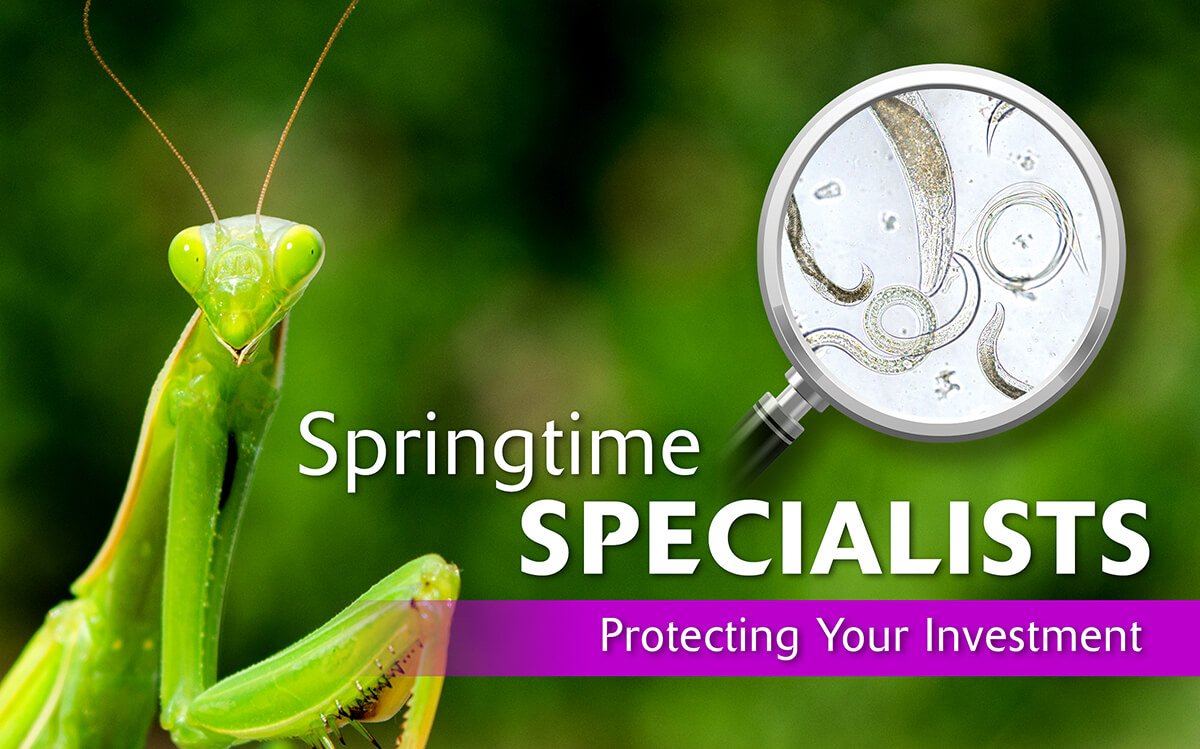Memorial Day weekend is nearly upon us. What is the best way protect the gardens you planted during this “shelter in place” season? And, what about those “murder hornets” that are starting to make headlines?
Here is the answer to your questions. Build an army! Here’s what you need to know about Praying Mantids, a natural enemy of the hornet. Another Guardian of the Garden are Beneficial Nematodes, who start to combat the pests in your yard right away! Read on for more information of these hard-working heroes and how they help protect your garden without the use of toxic chemicals and pesticides.

Praying Mantids
There are over 2400 species of Praying Mantids in the world. Some are native to North America, and many more have arrived here through international trade. The Chinese Praying Mantid, Tenodera Sinensis, was first recorded in the United States in the late 1800’s. Since then it has become well established in the northeastern part of the country.
Because they are completely carnivorous, each one eating large amounts of insects, they are often used as an alternative to chemical pesticides in the fight against pests. They are often sold to home gardeners to help control garden pests.
One of their advantages is that they do not actually travel to seek out their prey. They use camouflage and stillness to wait for their food to come to them. This means that while other beneficial insects will leave if they don’t find food, the Mantids can be introduced before there is a pest problem, where they will stay and wait for the pests to show up.
In fact, they are often sold as pets because they are very happy to stay on the gardener’s shoulder and eat bugs that are handed to them.

Additionally, Praying Mantids will not become overcrowded, because they are just as willing to eat each other as they are other insects. This means they can never become concentrated in any one area.
Sometimes, they may eat things that we would prefer that they didn’t, such as honey bees, solitary bees and butterflies. But this is rare, and it is all part of the balance of nature. Mostly, praying mantids eat the kind of pests we do want to eliminate, such as the nasty Asian Giant Hornet (a.k.a. Murder Hornet).

And of course, Praying Mantids are a food source for other creatures such as rodents, reptiles, birds, and cats.
Praying Mantids have been a good friend of the home gardener for over 100 years, and along with other beneficial insects, they will continue to have an important role in controlling pests in a chemical free landscape.
Beneficial Nematodes
The Beneficial Nematodes you can find in your nursery or garden center are nature’s one-stop solution for controlling over 230 soil dwelling pests!

Nematodes go to work immediately – they attack by invading those nasty grubs through any available orifice and killing them. Then they set about eating their prey from the inside out, and they finish by laying eggs inside the carcasses. It’s important to remember to leave those dead creatures in the soil, right where they died — the nematodes will use them as little nurseries to bring up the next generation! The carcasses will burst open, releasing millions more nematodes into the soil.
This is great news! Nematodes control over 230 pests. Did you know they kill fleas? With summer heat comes fleas. Nematodes make meals out of the flea larvae before they hatch and invade your pets! They also prey on things like moths, earworms, root maggots, fungus gnats, mole crickets, crown borers, and many more. And, the miracles never cease – they never harm earthworms!
The presence of earthworms always indicates healthy soil. Although nematodes are microscopic and can’t be seen with the naked eye, they can also be found in abundance in healthy soil. They are the top of the food chain; think of nematodes as the “sharks of the soil”.

Your customers may wonder if they really work since they are invisible to the naked eye and may even question if there is an actual product in the box. Here’s how you can tell the product is working as intended:
- The effects of adding them to the soil are immediate. Grubs die within hours, and the quantity of flying creatures that normally chew the leaves of your precious garden are visibly reduced, if not totally eliminated, within three to ten days of applying these nematodes.
- The results are long-lasting. Nematodes begin to breed and create the next generation right away. One box of nematodes will cover 2,000 square feet and could last for an entire year, if not longer (depending on weather).
- Nematodes go deep. The chemicals of today are designed to stay in the top couple inches of soil, supposedly to reduce penetration and prevent contamination of drinking water. Because Nematodes are completely natural, they can patrol the top 18 inches of soil, going after larvae that eat the roots of the plants before they fly up as adults to finish off the leaves of the plant.
- Nematodes provide two-for-one protection by decimating the larvae so that they never make it to adulthood.
Beneficial insects will save you time and money and protect your gorgeous home-grown spinach or beautiful flower garden from being destroyed from the bottom to the top.
Click here to find a garden center near you that carries Organic Control products.







